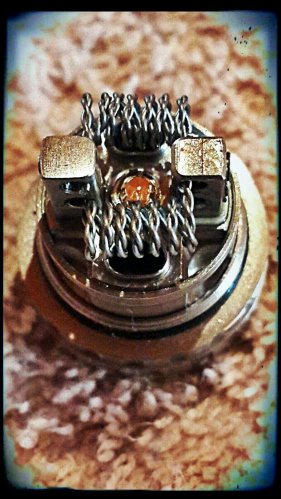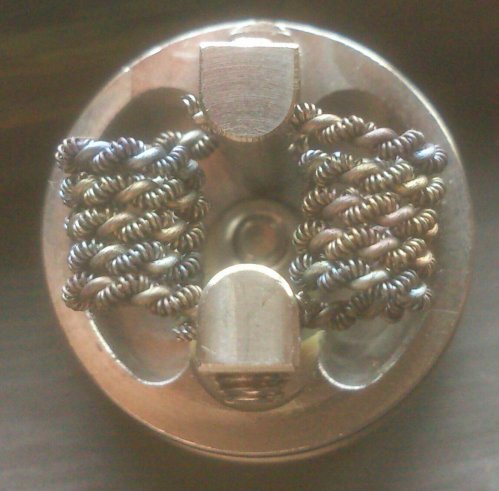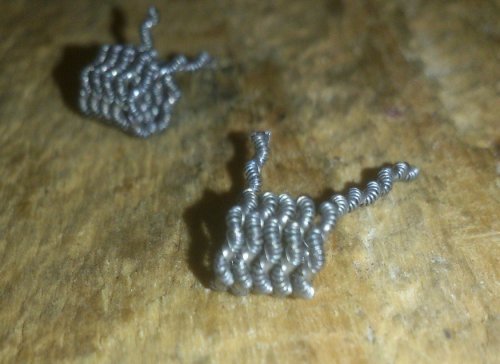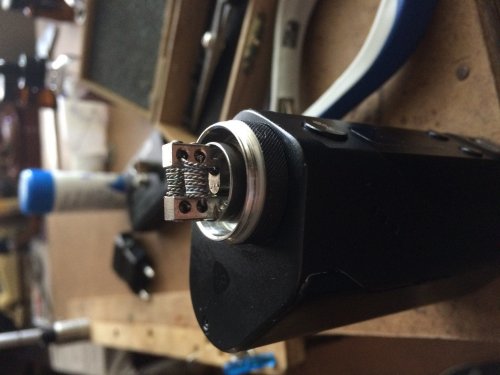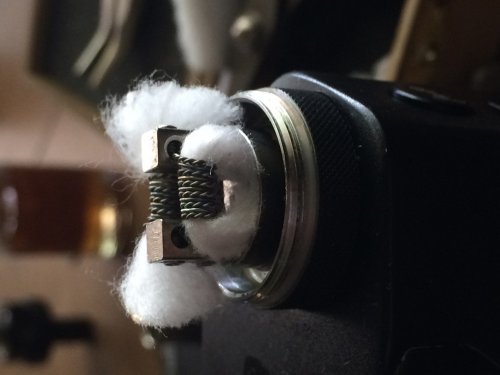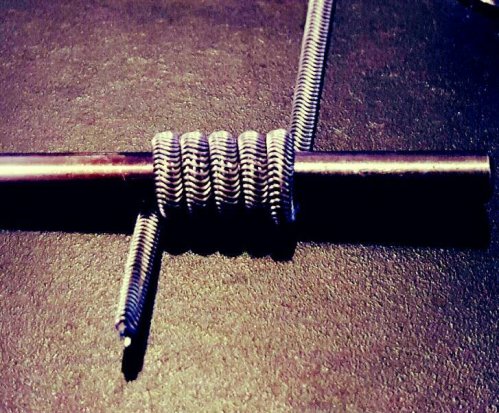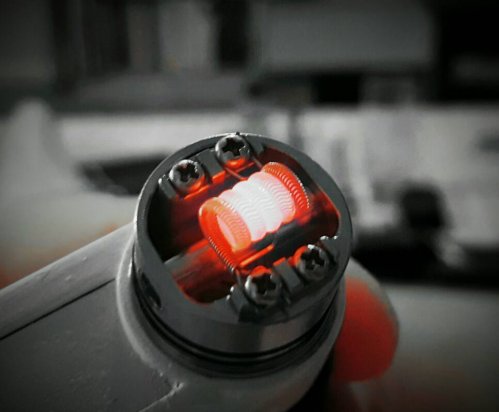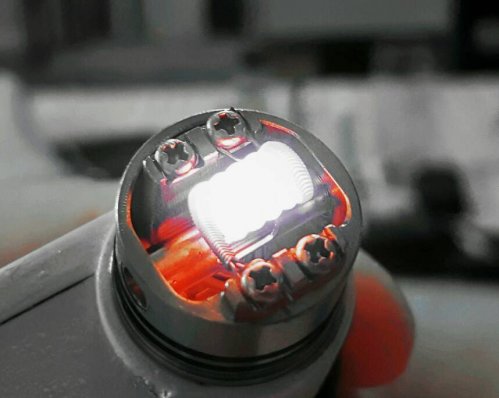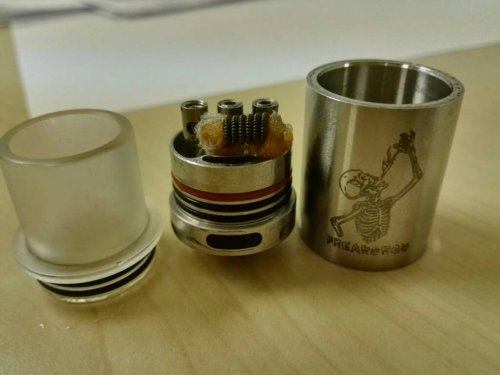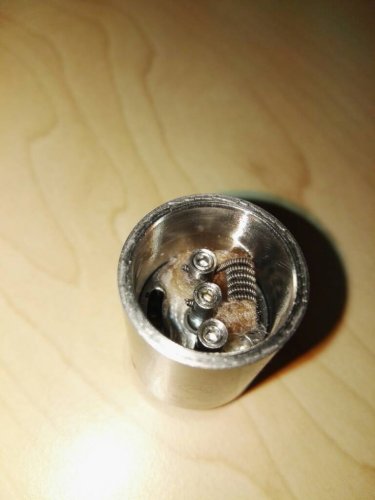Navigation
Install the app
How to install the app on iOS
Follow along with the video below to see how to install our site as a web app on your home screen.

Note: this_feature_currently_requires_accessing_site_using_safari
More options
You are using an out of date browser. It may not display this or other websites correctly.
You should upgrade or use an alternative browser.
You should upgrade or use an alternative browser.
Dem builds
- Thread starter wiesbang
- Start date
Dual parallel 26g + 32g clapton and 26g kanthal!

Sent from my iPhone using Tapatalk

Sent from my iPhone using Tapatalk
Finally pulled my favourite build of the last month in order to make space for a (TC) cloud-chasing build. Thought I'd share the build because I loved it.
This is a Quad-coil, two coils in series, connected in parallel to the post. 6 wraps each coil, 26 AWG SS 316L at 2.5 mm ID. 0.48 ohms. Mutation X v4.
Filthy build, but it is significant for a single reason: Because of the higher ohms, but still high surface area, you can get absolutely great TC with this build (best I've ever gotten from stainless steel), and fantastic flavour!
In my honest opinion, one of the best TC builds for flavour chasers out there! Not too difficult, likes high power but doesn't chuck as massive clouds as other, more exotic builds, and don't need no fancy wire nor drill yo! Just pure awesome flavour and mostly accurate TC!
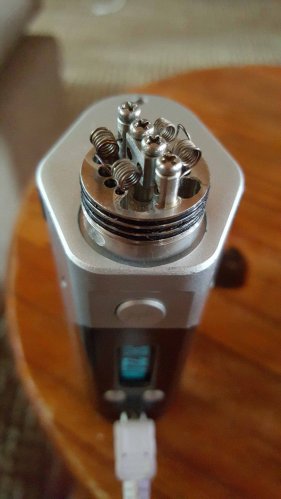
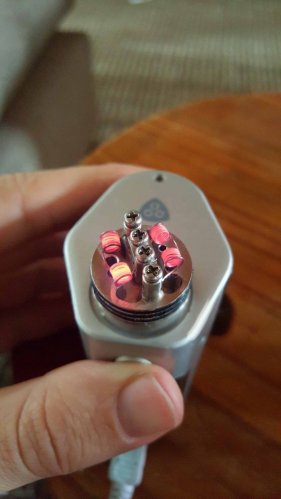
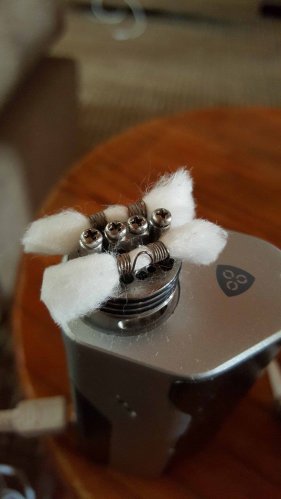
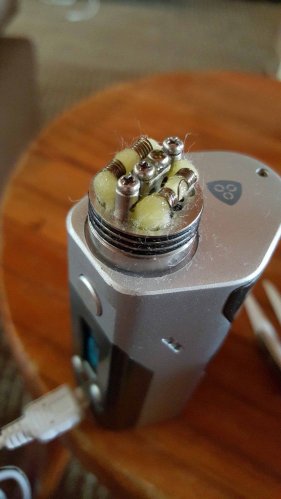
This is a Quad-coil, two coils in series, connected in parallel to the post. 6 wraps each coil, 26 AWG SS 316L at 2.5 mm ID. 0.48 ohms. Mutation X v4.
Filthy build, but it is significant for a single reason: Because of the higher ohms, but still high surface area, you can get absolutely great TC with this build (best I've ever gotten from stainless steel), and fantastic flavour!
In my honest opinion, one of the best TC builds for flavour chasers out there! Not too difficult, likes high power but doesn't chuck as massive clouds as other, more exotic builds, and don't need no fancy wire nor drill yo! Just pure awesome flavour and mostly accurate TC!




Chris that for a first attempt is outstanding. I have tried this and i no how difficult it is. Well done bro.First attempt at alien clapton... 3x26g/32g
View attachment 47034
View attachment 47035
View attachment 47036
Sent from my SM-N920C using Tapatalk
Sent from my SM-N9005 using Tapatalk
That looks amazing.View attachment 46692
Tricoil of one double twisted 28ga kanthal and two standard 28ga all around 2.5 mm. I aimed for 0.3 ohms to use on my kbox mini and nailed it. The twisted has 1.5 less wraps so they all ramp up not too far apart.
View attachment 46693
Today I tried my hand at spiral wire and is my favourote coil to date. Its only a single coil cos I didn't make enough of it.
Three 28ga spiral wire 6 wraps at 0.6 ohms

Sent from my GT-S6790 using Tapatalk
Thanks. It vapes amazing too. Almost as good as claptons but with the response time of standard micro coils and so far quite resistant to gunk. I now have dual spiral coils in my velocity and that same one relocated to my kanger subtank.That looks amazing.
Sent from my GT-S6790 using Tapatalk
Nice one, looks like a really nifty way to get great flavour without going to the hardware store before..Finally pulled my favourite build of the last month in order to make space for a (TC) cloud-chasing build. Thought I'd share the build because I loved it.
This is a Quad-coil, two coils in series, connected in parallel to the post. 6 wraps each coil, 26 AWG SS 316L at 2.5 mm ID. 0.48 ohms. Mutation X v4.
Filthy build, but it is significant for a single reason: Because of the higher ohms, but still high surface area, you can get absolutely great TC with this build (best I've ever gotten from stainless steel), and fantastic flavour!
In my honest opinion, one of the best TC builds for flavour chasers out there! Not too difficult, likes high power but doesn't chuck as massive clouds as other, more exotic builds, and don't need no fancy wire nor drill yo! Just pure awesome flavour and mostly accurate TC!
View attachment 46972 View attachment 46974 View attachment 46975 View attachment 46976
Could you elaborate around the relationship between the higher ohms and TC?
I'm running the same mod as you (RX 200) and a griffin rta, dual ss316l (±8 wraps) and getting 0.2Ohms, TC works pretty well - so pretty curious re: what you said..
TC measures resistance changes. Larger resistance changes are measured more accurately, which in principle means a mod can make finer adjustments to the power in order to keep the temperature constant (as well as prevent dry hits). For instance, take a look at these two graphs for a) Nickel temp-adjustment and b) Stainless Steel temp adjustment:
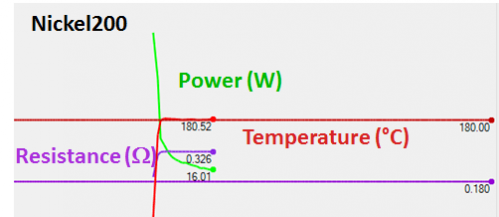
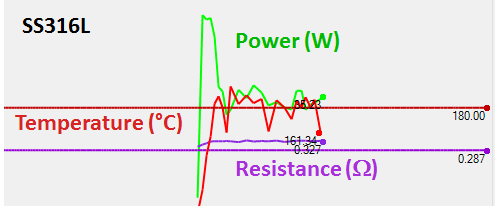
Notice how the power and temperature stays constant in the Ni build, whereas it fluctuates in the SS one?
It is one of those things where, once you've experienced accurate temp control, you have trouble working with sub-par TC. Especially on drippers, where the differences are larger. You can really feel the power fluctuating, resulting in a much more bumpy vape or (usually) a slightly aneamic vape.
Now, the resistance changes due to coil heating is greater the higher the initial ohms of the coil. For stainless steel (316L), a 1.0 ohm coil will increase by 0.00088 ohms for every degree Celcius above room temperature. On the other hand, a 0.5 ohm coil will only increase by 0.00044 ohms for every degree Celcius above room temperature, and a 0.1 ohm coil will increase by 0.00009 ohms for every degree Celcius above RT. Therefore, a mod can read the resistance changes for a higher ohm coil much more effectively than a lower ohm coil. In the end it is a play-off between how low you want to go without noticing a distinct change in the TC quality.
Don't get me wrong though - if TC works for you, then it works, and don't bother to change it. I just keep giving up on too low SS coils, so the slighty higher coil (without sacrificing surface area) worked wonders for me!
I updated my guide (in my signature) last night - somewhere in that wall of text you'll find more on this subject!


Notice how the power and temperature stays constant in the Ni build, whereas it fluctuates in the SS one?
It is one of those things where, once you've experienced accurate temp control, you have trouble working with sub-par TC. Especially on drippers, where the differences are larger. You can really feel the power fluctuating, resulting in a much more bumpy vape or (usually) a slightly aneamic vape.
Now, the resistance changes due to coil heating is greater the higher the initial ohms of the coil. For stainless steel (316L), a 1.0 ohm coil will increase by 0.00088 ohms for every degree Celcius above room temperature. On the other hand, a 0.5 ohm coil will only increase by 0.00044 ohms for every degree Celcius above room temperature, and a 0.1 ohm coil will increase by 0.00009 ohms for every degree Celcius above RT. Therefore, a mod can read the resistance changes for a higher ohm coil much more effectively than a lower ohm coil. In the end it is a play-off between how low you want to go without noticing a distinct change in the TC quality.
Don't get me wrong though - if TC works for you, then it works, and don't bother to change it. I just keep giving up on too low SS coils, so the slighty higher coil (without sacrificing surface area) worked wonders for me!
I updated my guide (in my signature) last night - somewhere in that wall of text you'll find more on this subject!
Thanks so much, this is great information!TC measures resistance changes. Larger resistance changes are measured more accurately, which in principle means a mod can make finer adjustments to the power in order to keep the temperature constant (as well as prevent dry hits). For instance, take a look at these two graphs for a) Nickel temp-adjustment and b) Stainless Steel temp adjustment:
View attachment 47152 View attachment 47153
Notice how the power and temperature stays constant in the Ni build, whereas it fluctuates in the SS one?
It is one of those things where, once you've experienced accurate temp control, you have trouble working with sub-par TC. Especially on drippers, where the differences are larger. You can really feel the power fluctuating, resulting in a much more bumpy vape or (usually) a slightly aneamic vape.
Now, the resistance changes due to coil heating is greater the higher the initial ohms of the coil. For stainless steel (316L), a 1.0 ohm coil will increase by 0.00088 ohms for every degree Celcius above room temperature. On the other hand, a 0.5 ohm coil will only increase by 0.00044 ohms for every degree Celcius above room temperature, and a 0.1 ohm coil will increase by 0.00009 ohms for every degree Celcius above RT. Therefore, a mod can read the resistance changes for a higher ohm coil much more effectively than a lower ohm coil. In the end it is a play-off between how low you want to go without noticing a distinct change in the TC quality.
Don't get me wrong though - if TC works for you, then it works, and don't bother to change it. I just keep giving up on too low SS coils, so the slighty higher coil (without sacrificing surface area) worked wonders for me!
I updated my guide (in my signature) last night - somewhere in that wall of text you'll find more on this subject!
No problem, hope it helps!Thanks so much, this is great information!
TC measures resistance changes. Larger resistance changes are measured more accurately, which in principle means a mod can make finer adjustments to the power in order to keep the temperature constant (as well as prevent dry hits). For instance, take a look at these two graphs for a) Nickel temp-adjustment and b) Stainless Steel temp adjustment:
View attachment 47152 View attachment 47153
Notice how the power and temperature stays constant in the Ni build, whereas it fluctuates in the SS one?
It is one of those things where, once you've experienced accurate temp control, you have trouble working with sub-par TC. Especially on drippers, where the differences are larger. You can really feel the power fluctuating, resulting in a much more bumpy vape or (usually) a slightly aneamic vape.
Now, the resistance changes due to coil heating is greater the higher the initial ohms of the coil. For stainless steel (316L), a 1.0 ohm coil will increase by 0.00088 ohms for every degree Celcius above room temperature. On the other hand, a 0.5 ohm coil will only increase by 0.00044 ohms for every degree Celcius above room temperature, and a 0.1 ohm coil will increase by 0.00009 ohms for every degree Celcius above RT. Therefore, a mod can read the resistance changes for a higher ohm coil much more effectively than a lower ohm coil. In the end it is a play-off between how low you want to go without noticing a distinct change in the TC quality.
Don't get me wrong though - if TC works for you, then it works, and don't bother to change it. I just keep giving up on too low SS coils, so the slighty higher coil (without sacrificing surface area) worked wonders for me!
I updated my guide (in my signature) last night - somewhere in that wall of text you'll find more on this subject!
It's for this exact reason I don't use SS in TC. I can feel the mod "pulsing" on and off rapidly trying to maintain the set temperature.
I don't have this issue with Ti or Ni - thanks @Ezekiel now I know that it's not all in my head
You have good reason to be chuffed with yourself. Well done.Hi guys. This is my first clapton coil build. I made the clapton myself and made this beautyView attachment 48255
I am quite chuffed with myself
Insane.....WHITE HOT !!!!! NICEFirst attempt at alien clapton... 3x26g/32g
View attachment 47034
View attachment 47035
View attachment 47036
Sent from my SM-N920C using Tapatalk
What wire is that ?
sanded 22g kanthal
Similar threads
- Replies
- 5
- Views
- 2K
- Replies
- 0
- Views
- 275
- Replies
- 0
- Views
- 1K
- Replies
- 2
- Views
- 1K


